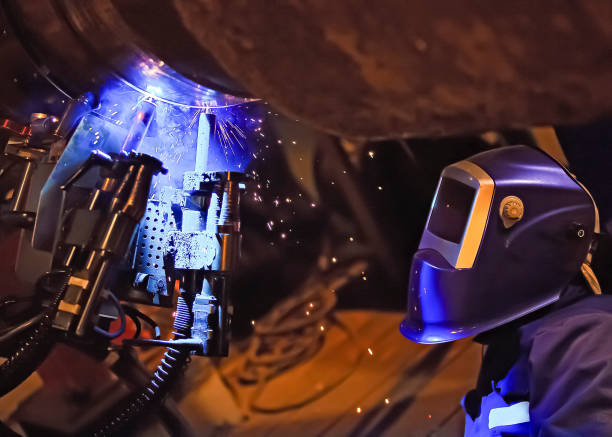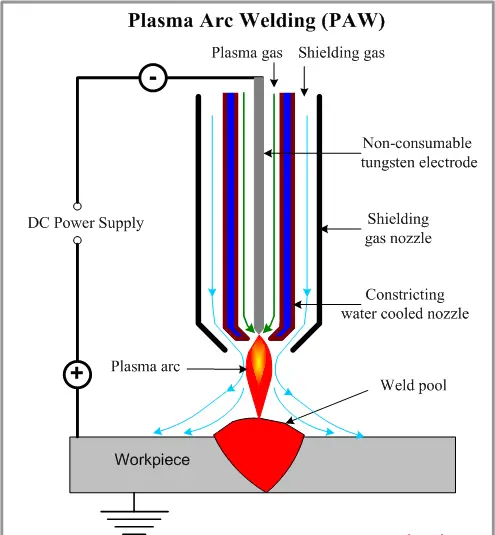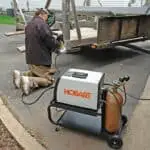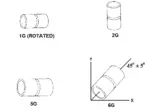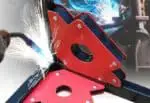Simply put, plasma is a gas that has been superheated to the point of becoming extremely conductive. This enables for the passage of electrical current during welding and cutting procedures. The temperature of a plasma arc may exceed 30,000 degrees Fahrenheit.
Plasma is made up of heated ionised gases. When an inert gas is given enough energy, some of its electrons break loose from its nucleus yet continue to travel with it. The atoms are transformed into a heated ionised state when the electrons leave.
It is the most frequent state of matter, often known as the fourth state of matter. These ionised atoms have a large heat capacity, which is then used to connect two plates. This is the fundamental concept of plasma arc welding.
Plasma arc welding has some drawbacks like it is a very noisy process. It also necessitates the use of highly trained welders and so, no novice welders should try to weld with this technique. The welding equipment is costly, complicated and emits greater radiation.
But before we get into its limitations, let us understand the process and working of Plasma arc welding.
What is Plasma Arc Welding?
Plasma welding, which was originally utilised as a welding method in the early 1960s, was employed in low-current applications (microplasma) of 0.5 amp or less, as well as up to 500-amp applications for heavy industries.
Although plasma welding is considered an exotic welding method in today’s industrial environment, it is nevertheless employed in a variety of sectors where production volume, consistency, and little downtime are critical.
Here are some fundamentals of plasma welding and how it differs from more traditional, mainstream procedures. Okay let’s get straight to the point and discuss some drawbacks of the plasma arc welding procedure.
Drawbacks of Plasma Arc Welding
1.) It emits UV and Infrared Radiation- his technique of welding generates ultraviolet radiation, which can harm or weaken polymers.
2.) The Initial Investment is High- The equipment and torch design are both costly, and equipment maintenance necessitates the use of trained specialists.
Torch failure can be disastrous for the operator, necessitating the use of extra safety measures. Plasma welding equipment is rather costly. As a result, start-up expenses will rise.
3.) Higher Noise Levels- While it reduces ambient heat, plasma cutting is loud and emits excessive fumes. Ensure that all plasma cutting is done in an open, well-ventilated workplace.
4.) Heat and Gases may Cause Harm to the Workpiece.
4.) Not Suitable for Thick Metals- Most plasma cutters are not suitable for heavier or denser metals. Because plasma is transient, its range is limited to around one inch.
If you need to cut through massive steel pillars or blocks, you may have to resort to classic industrial stitching or melting.
5.) Distorted Weld Finish- The single pass technique can induce thermal distortion if heat is focused in one place as a result of heat loss through the surface.
When heat is focused in one location, distortion occurs due to imbalanced heating, as opposed to a single pass procedure such as oxy-fuel cutting.
6.) High Maintenance Costs- Because the equipment is exceedingly expensive and difficult to replace or repair, maintenance is both necessary and costly.
7.) Novices Cannot Go For Plasma Welding- Plasma welding necessitates training and skill. To do plasma welding, you must first receive training and then be able to integrate and run a certain plasma welding machine.
8.) Expensive- While it is less expensive per cut than Oxy-fuel, plasma cutting can still be costly. Electrodes might be costly to obtain and replace if the system fails. Similarly, you may be required to pay for a specialised gas supply.
It might be difficult to create the necessary plasma mix if you do not have specialised equipment on hand.
But you know, the welding technique of plasma arc welding isn’t all that bad. It does have various limitations but it offers some good benefits too. And before we get to the benefits, let us understand a bit more about the working of plasma arc welding and its components.
Working of Plasma Arc Welding
Plasma arc welding is a welding procedure that generates a coalescence with the temperature created by a setup between a tungsten alloy electrode and the workpiece.
There are three types of gas supply utilised in plasma arc welding, including:
1.) Plasma Gas- The plasma gas supplied by the nozzle becomes ionised.
2.) Shielding Gas- This gas circulates throughout the external nozzle and shields the weld from air pollution.
3.) Back Purge Gas- The back purge gas is mostly employed while welding certain materials.
Plasma Arc Machining Components
1.) Plasma Gun: To make plasma, various gases such as nitrogen, hydrogen, argon, or a combination of these gases are employed. This plasma pistol features a tungsten electrode chamber.
This tungsten electrode is linked to the negative terminal of the DC power supply, while the nozzle of the plasma cannon is attached to the positive terminal. The gun receives the proper gas mixture. Between the anode and the cathode, a powerful arc is formed.
The electron of the arc then collides with the molecules of the gas, causing the gas molecules to become ionised and heat to be created.
2.) Power Supply: DC power supply The plasma gun’s power supply is utilised to create two terminals. A large potential difference is delivered between the cathode and anode, resulting in a powerful arc capable of ionising the gas mixture and converting it to plasma.
3.) Cooling Mechanism: A cooling system is added to the plasma cannon because it generates heat as hot gases constantly stream out of the nozzle.
To keep the nozzle cold, a water jacket is employed. A water jet surrounds the nozzle.
4.) Workpiece: This plasma arc machining can operate with a variety of materials. This procedure may be used to deal with metals such as aluminium, magnesium, carbon, stainless steel, and alloy steels.
Advantages of Plasma Welding
1.) Better Control of Arc- The benefit of plasma welding is the control and quality gained in the welded object due to the torch design. The torch design improves arc control and allows for a larger tolerance for in-torch stand-off distance.
2.) Freedom to Monitor and Control the Weld- With the torch design, both hands are free to move, and the head is accessible for weld observation and control. The use of technology enables applications such as remote monitoring and recording of the weld.
3.) Lower Levels of Spatter- Because of its efficient energy usage, the plasma arc produces less spatter than conventional welding processes. It also does not induce deformation in thin metals, therefore no preheating is required.
4.) The Increased Heat Concentration and Plasma Jet enable for Quicker Transit Speeds- The arc offers a more focused heat source, resulting in more efficient energy utilisation.
Because the plasma jet moves faster than the arc wire, travel time is reduced, allowing for quicker welding speeds.
5.) Smaller Heat Affected Zone- The heat affected zone is less than in GTAW because there is no energy release at the root of the bead due to the absence of filler metal. As a result, the heat affected zone is reduced and the welded zone looks better.
6.) There is Little or No Distortion Caused During Welding- Because no filler metals are used, there is no energy release at the root of the bead, resulting in negligible distortion to neighbouring materials.
The keyhole effect is enabled by plasma’s high temperature and high heat concentration. This enables full penetration when welding several joints in a single pass.
Applications of Plasma Arc Welding
The following are some of the plasma arc welding applications:
1.) Plasma arc welding is mostly used to create tools, dies, and moulds, among other things.
2.) Plasma arc welding is utilised in a variety of sectors, including aerospace and marine.
3.) Plasma arc welding may also be used to join stainless steel tubes and pipelines.
4.) It is used in the welding of turbine blades.
5.) Plasma arc welding is also useful in the electronics industry.
To conclude, plasma arc welding is one of the unique ways to bind metals. It has various advantages and drawbacks and it is essential for you to understand its limitations so that you can make an informed decision next time you think of employing plasma arc welding technique.

